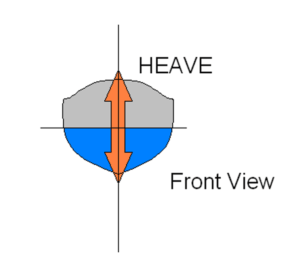
Expedition 390 ship motion (heave), as told through data
To increase accessibility to our expedition, click to listen to the page text read aloud.
We are excited to have so many ship-to-shore broadcasts scheduled for Expedition 390. In addition to providing teachers Educator Resources for EXP 390 for our two months at sea, we are providing some data that we collected during our time on the water. We suggest some questions you can use as a starting point to engage your students with the data. There are plenty of additional ways students can build their quantitative skills from our expedition, such as generating graphs for comparison or seeing if they can make any observations on their own.
Ship Motion on the Water
Out on the ocean, a ship experiences wind, currents, and wave action. These ocean and atmospheric dynamics will cause a ship to move in six different types of motions – heave, sway, surge, yaw, roll, and pitch. This video from Nautilus Live defines and explains each of these motions and how they can influence a ship at sea. It is important for the crew on board JOIDES Resolution to understand and track this information, as the data determine our safety and ability to drill.

For this post, we share the heave data experienced during our two months at sea for Expedition 390. The heave of a ship is defined as the linear, up-and-down (vertical) motion of the ship due to swells and wave activity lifting and lowering the entire ship.
We share some starter questions for teachers to use with students while exploring our heave data:
- If you were to plot this data for heave, what type of graph would you create? Which data would you put on each axis?
- Which day had the highest average heave? Was it the same day that had the highest maximum heave? Why might these days be the same date or different dates?
- Measure the wall of your classroom or something on your playground to five feet in height. How many days did JOIDES Resolution experience a heave of at least that height (five feet)?
- Calculate the average heave for the entire expedition.
- Why might someone want to look at the maximum heave instead of the average heave?
- What other data could you look at to better understand the heave experienced by the ship? For example, would it be helpful to know if the sun was out on a low heave day (think about it – does sunshine play a role in ocean heave)? Would it be helpful to know if there were strong winds that day? Etc.
- What do you think it would be like to walk on a ship during a day with a large heave? Do you think you could sleep during a day with a heave of three feet? Six feet? Ten feet? Explain.
Here you can access the full ship heave data for the expedition in the spreadsheet.
*Click on this link to open the entire file in Google Sheets (viewer mode only)
Important note! JOIDES Resolution can still core on days when the heave is 15 feet or less (from JR Ship Brochure). The ship has a heave compensation system for coring and logging, which lessens the impact of ship motion from either the drill string or the wireline logging tools. A passive heave motion compensator is used for drilling. The top drive, which rotates the pipe and drill bit, is attached to the motion compensator. As the ship rises and falls with the waves and swell, pistons keep the drill bit on the bottom. During logging operations, compensation is provided by the wireline heave compensation (WHC) system.
For additional quantitative exercises working with data from Expedition 390, please visit our other blog posts:
- Expedition 390 fuel, distance, time, and speed, as told through data
- Expedition 390 wind and ship’s heading, as told through data
- Blue Skies and Cloud Cover on Expedition 390 (*cloud cover data for the full expedition)
- Our Transit to the First Drill Site, As Told Through Data (*includes daily data for time of travel, distance, speed, wind, waves, swell, heave, during our initial nine-day transit)